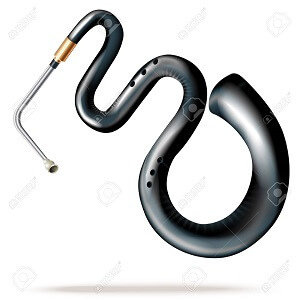Serpent
 The serpent is a wind instrument with a mouthpiece and finger holes. Though made of wood (and bound in leather), because the sound is created by vibrating the lips in the mouthpiece, as with the trumpet, the serpent is classed as part of the brass family. The 'serpent' derives its name from its S-shaped tube. The serpent is regarded as the bass of the cornetto family, but the serpent's bore is larger, the wall proportionately thinner and it does not have a thumb hole. The ivory or horn mouthpiece is attached to the end of a metal bocal. Using the six finger holes the player can play all the chromatic notes.
The serpent is a wind instrument with a mouthpiece and finger holes. Though made of wood (and bound in leather), because the sound is created by vibrating the lips in the mouthpiece, as with the trumpet, the serpent is classed as part of the brass family. The 'serpent' derives its name from its S-shaped tube. The serpent is regarded as the bass of the cornetto family, but the serpent's bore is larger, the wall proportionately thinner and it does not have a thumb hole. The ivory or horn mouthpiece is attached to the end of a metal bocal. Using the six finger holes the player can play all the chromatic notes.
The serpent's origin is far from clear, but many musicologists believe it hails from Italy. Be that as it may, from the beginning of the seventeenth century the serpent's heyday was in French churches where the instrument accompanied Gregorian plainsong. In the course of the eighteenth century the serpent was also used in military bands, where the snake-like instrument was made more manageable by giving it a more compact form. There were numerous regional variations in the design of the instrument; at one point there were even straight versions. Because those serpents resembled a bassoon, they were sometimes referred to as "Russian bassoons". It was not long before keys were added, enabling the player to use finger holes which were otherwise beyond his reach. This opened the way to the ophicleide. The serpent was played not only in France, but also in Belgium, Germany and England. In England, besides serving liturgical and military purposes, it also appeared in theatres.